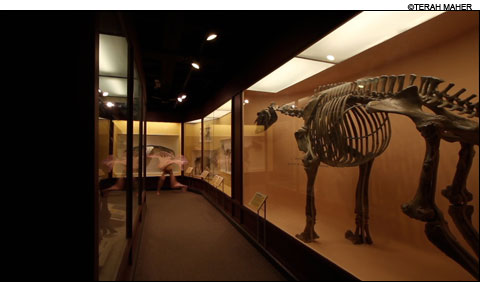
NATURAL WONDER Next week’s “Bizarre Animals” installation at the Harvard Museum of Natural History will fill the space with video, sculpture, animation, and more. |
While visiting Berlin's Museum Für Naturkunde, Boston architect Lisa Haber-Thomson felt a pang for a simpler era. The museum — an "old-fashioned, gross-snakes-in-jars kind of place" — was undergoing a room-by-room renovation. "Everyone was in the room with the old animals," she remembers. "Nobody was in the room with the interactive, light-up tree explaining biodiversity." It recalled Haber-Thomson to a time when museum displays didn't encourage visitors to engage with them.
"I remember going to museums when I was a kid and being able to wander around and have an imaginative experience," she says. "That's lost with these interactive displays. In a way, they're great because they're sharing information you wouldn't necessarily be able to get in other places, but it also takes that sense of exploration away."
Haber-Thomson organized the annual "Bizarre Animals" installation at the Harvard Museum of Natural History, in part to restore that wonder. On the evening of April 8, more than 20 artists will colonize the museum, transforming an already unnerving space filled with glass flowers, dinosaur bones, and taxidermy into an extra-unnerving art gallery. Light designers, poets, filmmakers, animators, sculptors, sound artists and an improv troupe are counted among their ranks, many of them recruited from Harvard's Graduate School of Design (GSD).
Because the museum's specimens are very old and delicate, participating artists must modify the exhibits without disturbing them in any significant way. And although they have some after-hours access to the museum, they will need to set up and take down their installations on the same night.
"People work hard on their pieces, so they want them to stay up longer, but it was also a challenging problem to solve," Haber-Thomson says. In addition to the time constraints and the difficulties of animating long-dead specimens, the space itself presents its own challenges. "It's a 19th-century building," says Tom Scanlon, the museum's assistant director for public programs. "Sometimes, it's a matter of not being able to find an [electric] outlet."
Haber-Thomson instructed the artists to "find some way to activate the space that's contemporary, but not the default video screen," she says. "['Bizarre Animals'] puts that space of play back into the museum."
STRANGE DISPLAYS
Terah Maher, a GSD graduate who teaches animation in Harvard's Visual and Environmental Studies Department, jumped at the chance to be playful. To make her animated film, Maher spent a number of hours dancing around the museum, in front of taxidermy cases, in underwear and a slip. "They let us come in one time in the evening, but we also did it [during public hours] when everybody was there, which was funny," she says. "People are kind of aware, but not. They want to stay out of your way, but they don't really know how to do that."
She partnered with filmmaker Michael Langan, whose short, Heliotropes, premiered at this year's South by Southwest. Together, they developed a method of animation that mingles Maher's form with that of the specimens. "I can't really divulge the technique — it's a little top-secret right now," she says. "The filming looks completely ridiculous — it's like we're making some bad modern-dance movie. But when we animate it, it's really stunning."